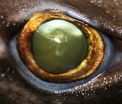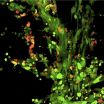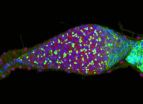(Press-News.org) PENSACOLA, Fla. — New research published in Environmental Toxicology and Chemistry addresses the effects of two broad-spectrum systemic insecticides, fipornil and imidacloprid, on honeybees. These insecticides are widely used in agriculture, and the authors conclude that fipronil and imidacloprid are inhibitors of mitochondrial bioenergetics, resulting in depleted cell energy. This action can explain the toxicity of these compounds for honeybees.
Scientists are urgently trying to determine the causes of colony collapse disorder and the alarming population declines of honeybees. The cross-pollination services they provide are required by approximately 80 percent of all flowering plants, and 1/3 of all agricultural food production directly depends on bee pollination. As a result, there has been a flurry of research on honeybee parasitic mite infestations, viral diseases, and the direct and indirect impacts of pesticides.
The effects of pyrazoles (e.g., fipronil) and neonicotinoids (e.g., imidacloprid) on the nervous system are fairly well documented. Daniel Nicodemo, professor of ecology and beekeeping at the Universidade Estadual Paulista in Dracena, Brazil, and lead author of the study states, "These insecticides affect the nervous system of pest and beneficial insects, often killing them. Sublethal effects related to insect behavior have been described in other studies; even a few nanograms of active ingredient disturbed the sense of taste, olfactory learning and motor activity of the bees." A key characteristic of colony collapse disorder is the incapacity of the honeybees to return to their hives, and these disruptions have a direct impact on that ability.
In this study, Nicodemo et al. looked at the effects of fipronil and imidacloprid on the bioenergetics functioning of mitochondria isolated from the heads and thoraces of
Africanized honeybees. Mitochondria are the power plants of a cell, generating most of a cell's supply of adenosine triphosphate (ATP), used as a source of chemical energy.
Honeybee flight muscles are strongly dependent on high levels of oxygen consumption and energy metabolism. Mitochondrial oxidative phosphorylation drives ATP synthesis, which is required to contract the muscles during flight. "If something goes wrong, the energy production is impaired," explains Nicodemo. "Similar to a plane, honeybees require clean fuel in order to fly." Both fipronil and imidacloprid negatively affected the mitochondrial bioenergetics of the head and thorax of the honeybees. While at sublethal levels, insecticide damage may not be evident, even such low level exposure clearly contributes to the inability of a honeybee to forage and return to the hive, which could result in declining bee populations.
INFORMATION: END
Fipronil and imidacloprid reduce honeybee mitochondrial activity
2014-08-06
ELSE PRESS RELEASES FROM THIS DATE:
Community religious beliefs influence whether wives work outside home, Baylor study finds
2014-08-06
Married women who live in communities in which a higher proportion of the population belongs to conservative religious traditions — such as evangelical or Mormon — are more likely to choose not to work outside the home, even if the women are not members of those faith groups, according to a Baylor University study.
The study — "Work-Family Conflict: The Effects of Religious Context on Married Women's Participation in the Labor Force" — appears in the journal Religions in a special issue, "Religion, Spirituality, and Family Life."
While previous research has shown individual ...
Photon hunting in the twilight zone
2014-08-06
The eyes of deep-sea bioluminescent sharks have a higher rod density when compared to non-bioluminescent sharks, according to a study published August 6, 2014 in the open-access journal PLOS ONE by Julien M. Claes, postdoctoral researcher from the FNRS at Université catholique de Louvain (Belgium), and colleagues. This adaptation is one of many these sharks use to produce and perceive bioluminescent light in order to communicate, find prey, and camouflage themselves against predators.
The mesopelagic twilight zone, or about 200-1000 meters deep in the sea, is a vast, ...
Young loggerhead turtles not going with the flow
2014-08-06
Juvenile loggerhead turtles swim into oncoming ocean currents, instead of passively drifting with them, according to a study published August 6, 2014 in the open-access journal PLOS ONE by Donald Kobayashi from National Oceanic and Atmospheric Administration and colleagues.
After loggerhead turtle hatchlings leave nesting beaches, they live in the ocean for 7-12 years before migrating to coastal habitats. Juvenile loggerhead turtles have good swimming abilities, but scientists aren't sure if they passively drift in ocean currents or actively swim. Combining turtle movement ...
HSCI researchers identify another potential ALS treatment avenue
2014-08-06
Cambridge, MA, Aug 6 - A series of studies begun by Harvard Stem Cell Institute (HSCI) scientists eight years ago has lead to a report published today that may be a major step forward in the quest to develop real treatments for amyotrophic lateral sclerosis, ALS, or Lou Gehrig's disease.
The findings by Harvard professor of Stem Cell and Regenerative Biology (HSCRB) Kevin Eggan and colleagues also has produced functionally identical results in human motor neurons in a laboratory dish and in a mouse model of the disease, demonstrating that the modeling of human disease ...
Dr. Brenna Anderson publishes commentary in BJOG
2014-08-06
Brenna Anderson, MD, of the Division of Maternal-Fetal Medicine at Women & Infants of Rhode Island and an associate professor of obstetrics and gynecology at The Warren Alpert Medical School of Brown University, has published a commentary in the current issue of BJOG: An International Journal of Obstetrics and Gynaecology, now available online. The commentary is entitled "The time has come to consider neonatal outcomes when designing embryo transfer policies."
Dr. Anderson offers her commentary in response to an article in the same issue by Kamphius et al. in which the ...
Brain tumors fly under the body's radar like stealth jets, new U-M research suggests
2014-08-06
ANN ARBOR, Mich. — Brain tumors fly under the radar of the body's defense forces by coating their cells with extra amounts of a specific protein, new research shows.
Like a stealth fighter jet, the coating means the cells evade detection by the early-warning immune system that should detect and kill them. The stealth approach lets the tumors hide until it's too late for the body to defeat them.
The findings, made in mice and rats, show the key role of a protein called galectin-1 in some of the most dangerous brain tumors, called high grade malignant gliomas. A research ...
NIST ion duet offers tunable module for quantum simulator
2014-08-06
BOULDER, Colo -- Physicists at the National Institute of Standards and Technology (NIST) have demonstrated a pas de deux of atomic ions that combines the fine choreography of dance with precise individual control.
NIST's ion duet, described in the August 7 issue of Nature, is a component for a flexible quantum simulator that could be scaled up in size and configured to model quantum systems of a complexity that overwhelms traditional computer simulations. Beyond simulation, the duet might also be used to perform logic operations in future quantum computers, or as a quantum-enhanced ...
Stowers researchers reveal molecular competition drives adult stem cells to specialize
2014-08-06
KANSAS CITY, MO — Adult organisms ranging from fruit flies to humans harbor adult stem cells, some of which renew themselves through cell division while others differentiate into the specialized cells needed to replace worn-out or damaged organs and tissues.
Understanding the molecular mechanisms that control the balance between self-renewal and differentiation in adult stem cells is an important foundation for developing therapies to regenerate diseased, injured or aged tissue.
In the current issue of the journal Nature, scientists at the
Stowers Institute for ...
Enhanced international cooperation needed in Antarctica
2014-08-06
Countries need to work together to ensure Antarctic research continues and key questions on the region are answered, researchers say.
In an article published in Nature this week, 75 scientists along with policy makers in 22 countries have outlined what they see as the major priorities for Antarctic research over the next 20 years and beyond.
In it they outline six priorities for Antarctic science – the most important scientific questions to be addressed in the region, as well as what they think is needed to achieve them.
One of the report's lead authors, Monash University ...
Mercury in the global ocean
2014-08-06
Although the days of odd behavior among hat makers are a thing of the past, the dangers mercury poses to humans and the environment persist today.
Mercury is a naturally occurring element as well as a by-product of such distinctly human enterprises as burning coal and making cement. Estimates of "bioavailable" mercury—forms of the element that can be taken up by animals and humans—play an important role in everything from drafting an international treaty designed to protect humans and the environment from mercury emissions, to establishing public policies behind warnings ...





